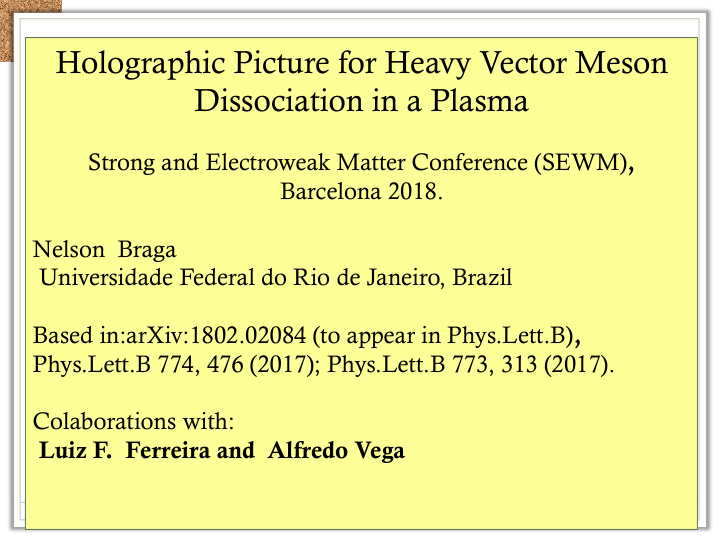



Holographic Picture for Heavy Vector Meson Dissociation in a Plasma Strong and Electroweak Matter Conference (SEWM) , Barcelona 2018. Nelson Braga Universidade Federal do Rio de Janeiro, Brazil Based in:arXiv:1802.02084 (to appear in Phys.Lett.B) , Phys.Lett.B 774, 476 (2017); Phys.Lett.B 773, 313 (2017). Colaborations with: Luiz F. Ferreira and Alfredo Vega
Motivation: describe the thermal dissociation of heavy vector mesons inside a quark gluon plasma using holography (AdS/QCD “botton up” model). In particular: density and magnetic field effects.
Gauge/String duality at finite temperature. Witten (1998): finite temperature version of AdS/CFT Black hole in Gauge Theory at ↔ anti-de Sitter space finite temperature The Hawking temperature of the black hole (B.H) is the temperature of the gauge theory. Charge of the B.H. è Density of the medium Einstein-Maxwell action è Magnetic field D'Hoker and P.Kraus, JHEP 0910, 088 (2009);1003, 095 (2010) 3
Important The holographic model must be consistent with masses and decay constants for mesons in the vacuum. Why do we have to worry about decay constants ?
Bottomonium Spectral function
Bottomonium Spectral function
In the limit of T è 0 Quasi-states è Dirac delta peaks of the meson states Two point function at zero temperature: Imaginary part: 11
Data for vector mesons cc c Relation between decay constant and eletron-positron width 12
Data for vector mesons The decay constants decrease with radial excitation level. This behavior is not reproduced by the original AdS/QCD models like: Hard wall , J. Polschinski, M.Strassler, 2002; H. Boschi-Filho, N. B. 2003. Soft wall , A.Karch, E.Katz, D.T.Son and M.A.Stephanov, 2006. D4-D8 , T. Sakai, S. Sugimoto, 2005. 13
How can one calculate decay constants and masses from holography? Correlator of gauge theory currents: Gauge string duality provides a tool to calculate the lefhand side of this equation . 14
Gauge string duality: vector fields in anti-de Sitter space work as sources for current correlators. Model: 3 parameters (“related to”): quark mass, string tension , large mass scale associated with the mass change in the non hadronic transition: heavy meson è leptons 15
16
Finite temperature and density: Finite temperature and background B field d(z) , q(z) = functions of T , B. 17
Spectral functions. Density effect in charmonium 18
Effect of magnetic field in Bottomonium. Magnetic field paralell to polarization 19
Effect of magnetic field in Bottomonium. Magnetic field perpendicular to polarization 20
Final remark: The background geometry represents just the effect of the magnetic field on the plasma. Magnetic fields could have also a direct effect of the charged constituents of the heavy mesons. Dudal and Mertens, Phys. Rev. D 91, 086002 (2015) Phys. Rev. D 97, 054035 (2018). DBI like action. Future plan: test the direct effect in this new holographic model. 21
Thank you !! 22
Recommend
More recommend